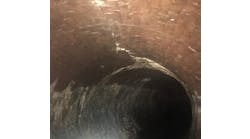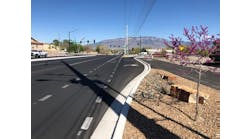Consumers Gas contracted Robert B. Somerville Pipeline and Utility Contractors, a division of Robert McAlpine, Ltd., to install 44 km of 8-in. gas line from Highway 400 due west to Orangeville, Ontario. This back-up feeder main line for Orangeville was installed on a relatively uncongested side road paralleling the existing main gas line, which ran south following Highway 9 into Orangeville.
Somerville's crews have 20 years of experience installing pipeline in all sorts of weather conditions. Still, the wet September slowed their production and tested their installation procedures, workers and equipment. "When we first were awarded the contract, we thought we could get the line in by the end of October," recalled Rodger Magee, general manager of Somerville. "But when it started pouring so hard and for so long, all of us doubted we'd be done before the snow started flying."
Hard weather conditions have always put workers and equipment to task, but rain is the enemy of pipeliners since it can ruin the best-cut trench, forcing on-site adaptations that take the entire crew off their normal high-productivity procedures.
"The biggest worry with the rain and the soggy ground conditions is losing the trench.," stated Gerry Genier, Somerville's job site superintendent. "If it collapses after you cut it, if it caves in, you can't go back with the trencher because then the ground won't support it. You have to use backhoes and smaller excavators, which causes your productivity figures to drop off dramatically."
Somerville had 10 major pieces of equipment on this site, including a directional drilling unit, two bulldozers, three rubber track backhoes, three side booms and a new 125-hp trencher. The directional drilling unit was used for the road crossings and pulling in the steel gas line through some marshy areas. According to Magee, the trencher purchase came in right on time. "We have older style bucket trenchers, but it was time to get into the modern age of trenching. The older ones practically required their own mechanic and welder to follow them around to keep them running. The feet-per-minute trenching we get with this new Vermeer T-455 made all the difference on this job. Even though we were trenching in a rural area, we still required plenty of versatility from this trencher.
"We considered a higher horsepower track trencher, but the size of this unit allows it to get into tight quarters that we sometimes encounter on these rural roads. We've found it has the power to cut through the hard clay, cobble and glacial till that is common here. Ontario has more varied ground conditions than anywhere else in Canada."
Each day, Sommerville's crew chief would cast a wary eye to the sky to get a feel for what kind of weather they would get. "The fear of losing the trench was always with us," said Genier. On good days, he could have the trencher open up a kilometer of new 14-in. wide, 60-in. deep trench all morning until about eleven o'clock. Then the operator of the trencher would saddle up a dozer and backfill if the welder and the side boom crews had installed the steel gas line. They were usually a couple of hours behind the trencher. But because of the wet, soggy ground, this was all the trench they could risk opening up.
"Because this was a main line, we were laying it in 5-ft deep and we always ran the risk of trench cave-in or the trench filling up with water," said Genier. "That limited our daily productivity." When it was raining, the normal procedure changed dramatically. In these conditions, Genier directed the trencher operator to "keep it tight."
An experienced crew like Somerville's knew this meant to only open up as much trench as you could install pipe into within two hours' time. During the heaviest of the rain showers, they cut only two to three 40-ft joints ahead of the welders and the side boom units.
The trencher operator constantly employed the tilt tracks of the T-455 when constructing the trench, which was usually one meter from the side of the road. With the soggy conditions, this feature paid for itself. "We knew we were cutting a narrow trench in wet ground," explained Genier, "so the trench walls had to be as straight as possible. When we were in a ditch, or on side slopes, being able to tilt and swivel the tracks hydraulically helped the machine cut the trench without cutting it at an angle that, with all the side pressure, most certainly would have led to a cave-in in these wet conditions."
And in rain, using the best equipment to lay pipe isn't just a bonus, it's a prerequisite to complete the job. Genier has been laying pipe for 25 years, and he knows the difference good equipment makes. "The newer equipment does make this job easier. You can cut the size of your crews down, and cut down the hours required for any given job. This trencher has replaced three backhoes and their operators that we otherwise would have used on this job. And we got more trench opened and pipe installed in less time. That's our goal."
Equipment is one necessary ingredient to successful pipe lining, but equipment dealer support is also crucial. Roger Magee knows first-hand what dealer support can mean to a job. "Early in the project, the trencher hit a rock and broke a cup-cutter adapter; later, we discovered we needed more depth and required a different size boom and chain. The Vermeer dealer saw to it that we were up and running within two days in both instances. That's the kind of backup and quick response that we needed in this lousy weather to get the job done."


